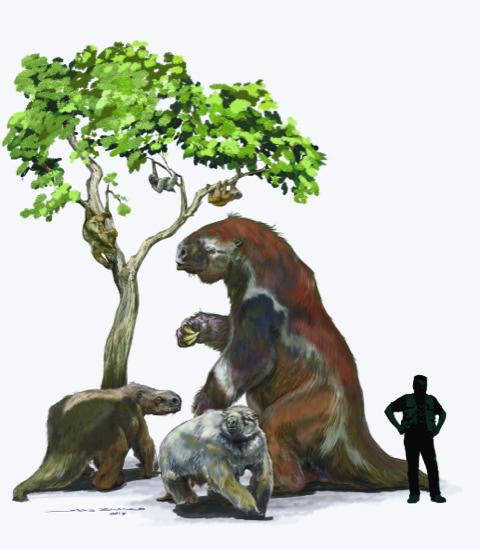Unique method finds two-toed sloths are last members of ‘extinct’ ancient family

Credit: Illustration by Jorge Blanco
Sloths once roamed the Americas, ranging from tiny, cat-sized animals that lived in trees all the way up to massive ground sloths that may have weighed up to six tons. The only species we know and love today, however, are the two-toed and three-toed sloths–but paleontologists have been arguing how to classify them, and their ancestors, for decades.
A pair of studies published June 6 have shaken up the sloth family tree, overturning a longstanding consensus on how the major groups of sloths are related. According to the results, the three-toed sloth is more closely related to a large family that included ancient elephant-sized ground sloths; meanwhile, the two-toed sloth appears to be the last survivor of an ancient lineage previously thought extinct.
“The results are surprising on many levels,” said Graham Slater, an assistant professor of geophysical sciences at the University of Chicago who co-authored one of the papers. “Not only do they rewrite sloth classification, they suggest much of what we thought we knew about how sloths evolved may be wrong.”
Slater’s study, published in Nature Ecology & Evolution, uses a pioneering approach that uses proteins in fossils to discover evolutionary relationships–marking the first time an entire lineage has been mapped with the method.
“All of these ancient sloths must have occupied really important roles in grazing and browsing the landscape, and so they’re important to understanding how these ecosystems worked, but getting a handle on their evolution has been difficult,” said Slater, who specializes in analyzing the patterns of evolution in mammals.
The existing hierarchy is built on how physically similar the fossils look to one another. But Slater, working with Ross MacPhee with the American Museum of Natural History and Samantha Presslee at the University of York, wanted to explore the possibilities of an emerging field called paleoproteomics–extracting information from proteins inside fossilized bone.
Instead of DNA, which is a fragile molecule that needs specific conditions to survive inside fossils–“getting ancient DNA is a bit of a lottery,” Slater said–scientists have been looking at proteins instead. Protein molecules are sturdier, and since DNA is translated directly into proteins, they hold much of the same information. So the scientists extracted collagen from multiple fossils, analyzed it to reconstruct the sequences of amino acids, and then compared these to one another to piece together relationships between the species.
“What came out was just remarkable. It blew our minds–it’s so different from anything that’s ever been suggested,” Slater said.
Previously, scientists thought that the unau–the three-toed sloth with cute black lines around its eyes–was an outlier species that diverged early in the group’s evolution. But based on the new evidence, it actually appears to be nested within a large group of different ground sloths that includes those gigantic, elephant-sized sloths.
Meanwhile, the ai (or two-toed sloth) had been classified in with a family called Megalonychidae, which includes everything from Central American and Caribbean sloths to an Ice Age-era American ground sloth that was first described by Thomas Jefferson (due to the fossil’s large claws, he thought it was a lion). But according to the findings, two-toed sloths are actually the last survivors of a branch previously thought to be extinct, which likely split off about 20 million years ago.
The protein evidence also revealed that those extinct Caribbean sloths were the descendants of an early branch that split from other sloths around 30 million years ago. This is interesting evidence for another longstanding question: whether there was a short-lived land bridge connecting South America and what would become the West Indies, many millions of years ago. If wanderlust drove ancient sloths across the bridge, their presence in the islands would support that idea. Thus far no conclusive fossil evidence has turned up, but the genetic split 30 million years ago makes sense if those sloths were then geographically isolated after the land bridge disappeared.
The new conclusions also cast doubt on our picture of how sloths evolved, because the West Indian sloths look as though they lived in trees. “We’ve been used to thinking that today’s sloths each evolved independently for life in the trees from a ground-dwelling ancestor, but our results suggest that the ancestral sloth may have been at home in both,” Slater said.
Though revolutionary, the results square with a DNA analysis released the same day by a group with the French National Centre for Scientific Research and other institutions. That group was able to pull mitochondrial DNA from several critical fossils, and the two independent analyses align very closely. “Exceptional results demand exceptional verification,” said MacPhee, so the two groups agreed to publish simultaneously.
The team is excited about pushing the boundaries of the field of paleoproteomics. Evolutionary paleobiology is greedy for more and older data, and proteins could provide it.
“The very oldest DNA you can get is 800,000 years old, but in theory we should be able to get protein data from specimens that are millions of years old,” Slater said. “A whole bunch of questions suddenly come into reach. It opens doors that we were only dreaming of.”
###
Media Contact
Louise Lerner
[email protected]
Related Journal Article
http://dx.




